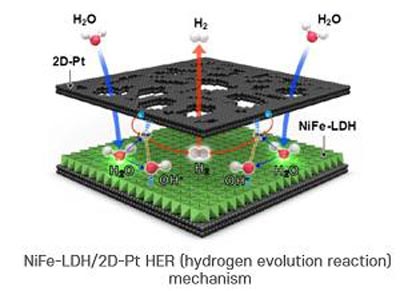Sandwich catalysts offer higher activity and durability

NiFe-LDH/2D-Pt HER (hydrogen evolution reaction) mechanism
Credit: In Su Lee (POSTECH)
Sandwich is the food concocted by the 18th-ceuntry nobles to play card games uninterrupted. Meat or vegetables were layered then tucked between bread to be eaten quickly while engaged in the game. This efficient food also delivered ample calories and nutrition.
POSTECH research team has discovered that layering like the sandwich is an excellent way to obtain hydrogen energy, an alternative energy source for fossil fuels.
The research team led by Professor In Su Lee, SunWoo Jang, a student in the MS/PhD integrated program, and Dr. Soumen Dutta of the Department of Chemistry at POSTECH have together developed a sandwich structured catalyst that can efficiently generate hydrogen energy by activating water electrolysis. The research findings were recently published in the American Chemical Society’s international journal ACS Nano.
Hydrogen fuel cells are eco-friendly power-generating devices that generate electricity using chemical reactions that produce water (H2O) from oxygen (O2) and hydrogen (H2). With the recent release of hydrogen-powered vehicles and the spread of hydrogen fuel cells in households, hydrogen is widely seen as the next-generation energy source to replace fossil fuels.
The way water is decomposed and hydrogen is produced using surplus current obtained from solar or wind power is considered the easiest and most eco-friendly way to produce high purity hydrogen fuel in large quantities. However, this method has a disadvantage of being low in production efficiency and high in cost. In order to lower the unit price of hydrogen fuel produced through water electrolysis, it is necessary to develop highly active and stable electrochemical catalysts that can maximize hydrogen generation efficiency.
Platinum (Pt) has been considered the most suitable catalyst for hydrogen-producing reactions, but its low affinity for water molecules and the resulting slow rate of water electrolysis make it difficult to apply to commercial processes that take place under alkaline electrolyte conditions. To make up for these limitations, many attempts have been made to combine metal-sulfide with platinum nanoparticles that promote water electrolysis, but the unstable nature of platinum/metallic-sulfide surfaces poses another weakness that significantly reduces the durability of catalysts.
In response, the research team designed a two-dimensional form of platinum/metal-hydroxide interface to improve the efficiency and durability of catalysts at the same time. In an original technique to grow a platinum layer of about 1 nm on the surface of nickel/iron-double-hydroxide(LDH), which is several nanometers thick, 2D-2D nanohybrid materials in the form of sandwiches containing 2D-nickel/iron-hydroxide-nano plates have been successfully synthesized.
The synthesized sandwich catalyst has a synergistic catalytic effect between metal-hydroxide and platinum, which are in close contact across a wide 2D-2D interface. At this time, it shows more than 6 times the activity of the conventional catalytic material (20%-Pt/C), and maintains stable catalytic function without decreasing activity even in the hydrogen-producing water electrolysis for more than 50 hours.
“Sandwich catalysts have the highest alkali solution hydrogen-producing catalytic activity among substances that do not use carbon supports, but are significantly more durable than similar electrochemical catalysts that are stable for just three to five hours,” said Professor In Su Lee who led the research. “We expect them to be applied to developing a cost-effective process for hydrogen production.”
###
This research was conducted with the support from the Research Leader Program (Creative research) of the National Research Foundation of Korea.
Media Contact
Jinyoung Huh
jyhuh@postech.ac.kr
82-542-792-415
Original Source
http://postech.
Related Journal Article
Media Contact
All latest news from the category: Power and Electrical Engineering
This topic covers issues related to energy generation, conversion, transportation and consumption and how the industry is addressing the challenge of energy efficiency in general.
innovations-report provides in-depth and informative reports and articles on subjects ranging from wind energy, fuel cell technology, solar energy, geothermal energy, petroleum, gas, nuclear engineering, alternative energy and energy efficiency to fusion, hydrogen and superconductor technologies.
Newest articles

Magnetic Memory Unlocked with Energy-Efficient MRAM
Researchers from Osaka University introduced an innovative technology to lower power consumption for modern memory devices. Stepping up the Memory Game: Overcoming the Limitations of Traditional RAM Osaka, Japan –…

Next-Level System Security: Smarter Access Control for Organizations
Cutting-Edge Framework for Enhancing System Security Researchers at the University of Electro-Communications have developed a groundbreaking framework for improving system security by analyzing business process logs. This framework focuses on…

How Microbial Life Shapes Lime Formation in the Deep Ocean
Microorganisms are everywhere and have been influencing the Earth’s environment for over 3.5 billion years. Researchers from Germany, Austria and Taiwan have now deciphered the role they play in the…



